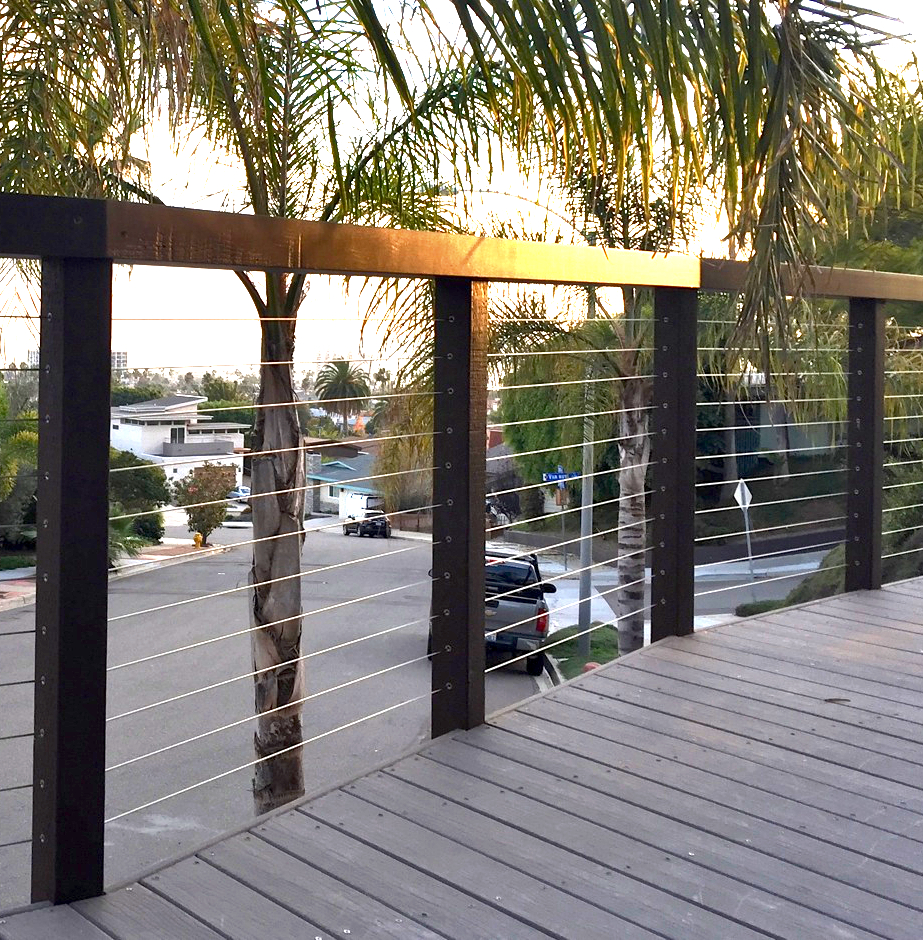




Infill Spacing for Safe Decks Building codes nationwide hold to a 4″ maximum clear spacing requirement for railing infill sections. Whether constructing new or retrofitting older barrier railings the code spacing requirement remains the same. By definition this means that no gap anywhere on the railing should exceed 4″ clear in between members. Older homes, condominiums, and commercial buildings with outdated railings may need to be upgraded in order to satisfy this requirement. Older code spacing (6″-8″) increase liability due to possible falls or injury caused by larger spacing requirements that could allow children through railing members. Newer codes and standards for child safety require tighter gapping. Safer deck railings utilize current codes with sturdy frames and max clear spacing of 4″. Cable rail spacing requires a max 3″ space to allow for deflection. Safer Decks Require Current Codes and Practices The 4″ maximum spacing requirement used for current codes was designed to prevent small children from being able to force their head or body into and through any gaps anywhere on the railing system. Safe railings are all about child safety requirements. In this article we will explore information necessary to upgrade your railing systems and make them safer for children, pets, and people. Railing Heights Vary by State Railing height specifications can vary by state and we recommend checking with current local building codes prior to construction. In California, a minimum railing height of 42″ is required. Other states like Arizona still hold to a 36″ railing height requirement. How to measure for finished railing height? Railing height should be measured from the top of the deck surface to the highest point of the top rail member. When performing site verifications our installers measure from multiple locations across the deck surface. Deck levels can vary, especially when dealing with slopes so it’s best to verify railing height in multiple locations. Vertical and Horizontal Rail Spacing Checking for voids along the railing frame is a good way to make sure your railings meet current codes. Safe deck railings should not contain any gaps larger than 4″. The following are common locations where these voids may occur: –Upright or Vertical Members – check spacing between pickets, posts, and or pipes, also check cables for 3″ spacing compliance –Horizontal railing members– bottom rails should be code spaced from the deck surface. Cable spacing should not exceed 3″ in order to prevent more than 4″ when deflection occurs. Solid members like pipe and/or wooden railing parts that do not deflect can be spaced at 4″ from center of member to member Glass infill – glass panels, lattice or solid wood, steel or other aesthetic panels should not have gaps larger than 4″ in between panels or scrollwork. Hiring Railing Pro to Construct Safer Deck Railings A large number of our customers hire a railing professional to guarantee safety and code compliance. Our preferred installers are licensed contractors; familiar with local and current code requirements. Some custom and higher risk applications like raised decks, balconies, and stairs greatly benefit from using pro’s. Our DIY products and solutions are very popular and easy to install however some applications are better suited for hiring a specialized contractor. HOA’s, and condo complexes are often required to use professional contractors for construction projects. Insurance claims also require the use of a professional. Large scale industrial projects, commercial, and retail spaces are best handled by licensed professionals. Our team at San Diego Cable Railings has been fabricating and installing code compliant railings since 2009. If you are interested in learning more please give us a call or visit the quote request page to receive an estimate. CLICK HERE TO SUBMIT A QUOTE REQUEST Cable Railing News Stair Railing Ideas MavenSeptember 6, 2024 Safe Deck Railings Pony Wall Railing Renovations MavenAugust 20, 2024 kids and cable railings, Safe Deck Railings Safer Deck Railings MavenJuly 31, 2024 deck railing costs Deck Railing Costs MavenJuly 16, 2024 glass railing posts All Purpose Railing Posts MavenJune 30, 2024 Browse More Posts

Code Compliant Clear Spacing Building codes nationwide hold to a 4″ maximum clear spacing requirement when it comes to constructing new or retrofitting older barrier railings. More simply stated; this means that no gap anywhere on the railing should exceed 4″. Older homes, condos, and apartment buildings with outdated railings may need to be upgraded due to this requirement. Being grandfathered in at an older code spacing requirement may not prevent liability due to possible falls or injury caused by outdated spacing requirements. Newer codes and standards for child safety railings require tighter spacing than standards from decades ago. What’s the reason for newer and tighter spacing requirements? The 4″ max spacing requirement used for current codes was actually designed to prevent small children from being able to force their head or body into and through the gap anywhere on the railing framework. It’s been this way for some time now and it really boils down to child safety requirements. In this article we will share some information necessary to upgrade your railing systems and make them safer for children, pets, and people. Code Railing Height by State Railing height considerations can vary by state and it is recommended that anyone considering new railing construction or retrofit check with local building codes prior to installation. In California, a minimum railing height of 42″ is required. Some states still hold to a 36″ railing height requirement. How do I figure out my railing height? Railing height should be measured from the top of the deck surface to the top of the railing cap member. A good rule of thumb is to measure from multiple locations to ensure uniformity across the surface. Decks and patios can vary, especially when dealing with slopes so it’s best to check height in multiple locations. Railing Gaps, Vertical and Horizontal Member Spacing Checking for gaps along the railing framework is a good way to make sure your railings meet current codes. Child safety railings should not contain any gaps larger than 4″ and there are common locations where this may occur: –Vertical Members – check spacing between pickets, balusters, and or vertical pipes, cables for compliance –Horizontal members– bottom rails spaced from deck surface, horizontal pipe or cable spacing. Cable spacing should not exceed 3″ in order to prevent more than 4″ when spread. Solid horizontal members like pipe and/or wooden railing members that do not move can be spaced at 4″ clear –Panels– glass panels or solid wood, steel or other panels should not contain gaps larger than 4″ in between panels Hiring a Professional for Safer Railings Many people choose to hire a deck builder or railing professional to guarantee safety and code compliance. Hiring a licensed contractor that is familiar with local and current code requirements is a good option for higher risk applications like raised decks, balconies, etc. DIY products and solutions are very popular and effective but there are also applications that are better suited for hiring a professional installer. High rise multi unit complexes, HOA’s, and municipalities are often required to use professional contractors for construction projects. Additionally, insurance claims often require the use of a professional. From a railing application standpoint; stairs, angled applications, large scale projects, commercial, and industrial projects are best handled by licensed professionals. Our team at S.D.C.R. has been fabricating and installing child safe, code compliant railings for nearly 2 decades now. If you are interested in learning more please give us a call or visit the quote request page to receive an estimate. ADA Compliant Railings, Architecture test post MSimontonApril 2, 2024 Cable Railing News, kids and cable railings Child Safety Railings MavenMarch 28, 2024 cable railing code, Cable Railing News Height Standards for Deck Railings MavenMarch 5, 2024 Stainless Steel Cable Railings Choosing the Right Stainless Steel Cable Railing for Your Deck Cole RouseJanuary 24, 2024 Stainless Steel Cable Railings Why Stainless Steel Railings Are a Safe and Sleek Design Option Cole RouseJanuary 24, 2024 Browse More Posts
Keep Your Children and Pets Safe Without Spoiling the View! We recently launched a new page on our website addressing some popular questions on the topic of cable railings and child safety. Children and parents alike love our railings because of the sleek aesthetics and sturdy construction. Animals love cable railings because they have the ability maintain a safe barrier without making our pets feel contained or confined. Here are some additional reasons to consider an SDCR cable railing system for your indoor and outdoor living spaces: Stainless Cable Systems Offer a Modern Look and Feel A Wide Variety of Design Options, Colors and Materials Available No Glass to Clean! No Little Fingerprints Safe, Code Compliant and Engineered Products for Permit Submittals T316 Stainless Offers Unmatched Durability and Corrosion Resistance Cable Railings are DIY Friendly! SDCR team members are always available by phone or online to answer questions and provide estimates for your project. We have DIY packages available, as well as expert preferred installers if you prefer a turn key railing project. For more information about why kids love San Diego Cable Railings, give us a call at 844-277-7327 or visit the quote request page. Kids Love San Diego Cable Railings

Safety is at the top of the list when it comes to stainless cable railings and raised decks. While most municipalities have adapted to the popularity of cable railing systems, some questions still arise. What is the truth about climbable railings? Do horizontal railing members allow children to climb? What is the ladder effect? The ladder effect is caused by sequential horizontal members that in theory could be easier to climb than vertical railing members because of the orientation and direction. Stainless cable railings were frowned upon and even prohibited years ago because of this possibility; BUT WHAT is the truth and WHERE are the statistics?